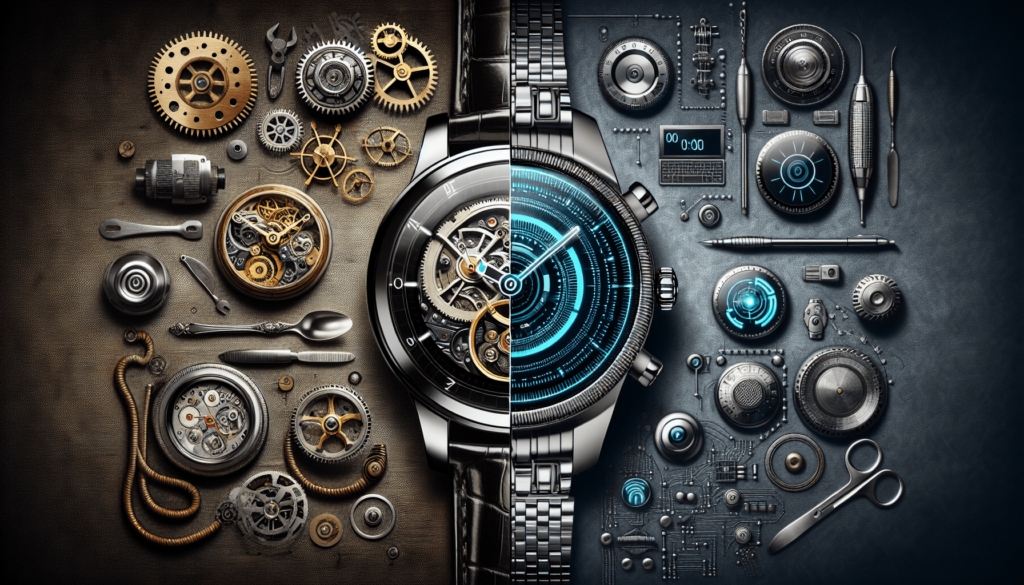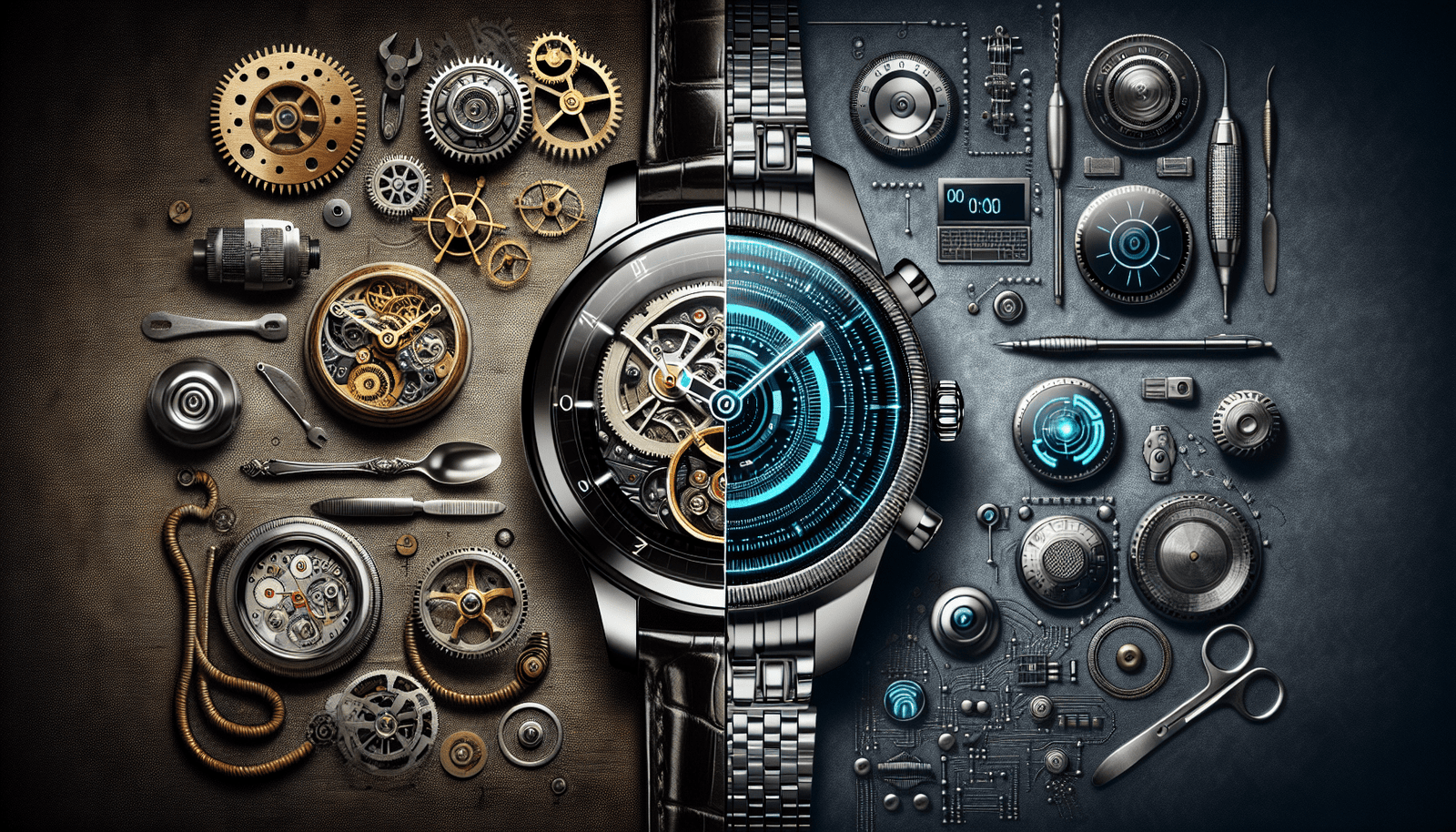Will Smartwatches Ever Replace Traditional Watches?
If you’ve ever wondered about the future of timekeeping, you’re not alone. The debate between smartwatches and traditional watches has been ongoing, and it shows no signs of slowing down. While some argue that smartwatches will inevitably replace their traditional counterparts, others believe there will always be a place for the classic timepiece. In this article, we’ll explore the various factors that come into play when considering the potential replacement of traditional watches by smartwatches. So, whether you’re a tech enthusiast or a watch aficionado, get ready to weigh in on the age-old question: will smartwatches ever replace traditional watches?

Introduction
Welcome to our comprehensive article on the debate of smartwatches vs traditional watches. In today’s fast-paced and technologically advanced world, the rise of smartwatches has sparked a conversation about their potential to replace the timeless elegance and functionality of traditional watches. In this article, we will delve into the history of watches, the rise of smartwatches, the comparison of functionality, fashion and style, fitness and health tracking capabilities, Battery life and charging, as well as the cost and value of both types of watches. By exploring these aspects, we hope to provide you with a holistic view of the smartwatches vs traditional watches debate, allowing you to make an informed decision about which watch suits your lifestyle and preferences best.
History of Watches
Early Timekeeping Devices
The history of watches dates back centuries, with the earliest timekeeping devices being simple sundials and water clocks. These early devices relied on the movement of the Sun and the steady flow of water to measure time. As civilization advanced, mechanical clocks were invented, leading to the development of pocket watches. These pocket watches became popular among the aristocracy and were seen as a symbol of status and sophistication.
Invention of the Wristwatch
The invention of the wristwatch revolutionized the way people accessed time. It was during the late 19th and early 20th centuries that wristwatches gained popularity, particularly among military personnel during World War I. The convenience of having time displayed on the wrist allowed soldiers to synchronize their maneuvers and enhanced timekeeping accuracy on the battlefield. From then onwards, wristwatches became widely embraced and evolved into fashionable accessories.
Popularity of Traditional Watches
Traditional watches have stood the test of time due to their timeless appeal and meticulous craftsmanship. The precision and reliability of mechanical movements in traditional watches continue to captivate watch enthusiasts and collectors. These watches are often passed down as heirlooms, carrying with them sentimental value and a sense of connection to the past. Traditional watches have become an iconic fashion statement, admired for their elegance and class.
Rise of Smartwatches
Introduction of Smartwatches
The rise of the digital age brought about the introduction of smartwatches. Smartwatches are technologically advanced timepieces that offer a range of features beyond traditional timekeeping. With the ability to connect to smartphones and other devices, smartwatches have become an extension of our digital lives, providing quick and convenient access to notifications, messages, and apps right on our wrists.
Advances in Technology
One of the key factors driving the popularity of smartwatches is the rapid advancement of technology. Smartwatches now come equipped with a variety of sensors and components, such as heart rate monitors, GPS, accelerometers, and even ECG capabilities. These technological advancements allow smartwatches to track our activities, monitor our health, and provide personalized insights about our well-being.
Integration of Smart Features
Smartwatches have evolved beyond timekeeping devices to become multifunctional tools that can handle a wide range of tasks. From making phone calls and sending messages to controlling smart home devices and tracking fitness goals, smartwatches offer a level of convenience and connectivity that traditional watches cannot match. The integration of smart features has made smartwatches an indispensable companion in our increasingly digital lives.
Comparison of Functionality
Timekeeping Accuracy
When it comes to timekeeping accuracy, traditional watches powered by mechanical movements are renowned for their precision. These watches rely on intricate gears and springs to keep time, ensuring minimal deviation from the standard. On the other hand, smartwatches, being digital devices, rely on quartz or atomic movements, which provide accurate time but may require occasional calibration.
Additional Features of Smartwatches
Smartwatches offer a wide range of additional features that go beyond timekeeping. These include fitness tracking, sleep monitoring, music playback, contactless payments, and even the ability to install and use third-party apps. The ability to receive notifications and stay connected without having to constantly check our smartphones is a major convenience offered by smartwatches.
Durability and Reliability
Traditional watches, especially those made with high-quality materials and craftsmanship, are known for their durability and reliability. Mechanical movements are proven to withstand the test of time and can be seen as a long-term investment. On the other hand, smartwatches, being electronic devices, may have a shorter lifespan due to technological advancements and inevitable wear and tear. However, advancements in smartwatch technology have allowed for improvements in durability, with some models now boasting water resistance and rugged construction.

Fashion and Style
Traditional Watches as Fashion Statements
Traditional watches have long been regarded as fashion statements, reflecting personal style and individuality. The wide range of designs, materials, and complications available in traditional watches allows wearers to express their taste and sophistication. Whether it’s a sleek and minimalistic dress watch, or a bold and sporty diver’s watch, traditional watches offer a level of customization and elegance that can enhance any outfit and make a lasting impression.
Customization Options of Smartwatches
Smartwatches offer a different kind of customization compared to traditional watches. With digital displays and customizable watch faces, smartwatches allow users to change the look and feel of their watch with just a few taps. From traditional analog-style faces to futuristic digital designs, the possibilities are endless. Some smartwatches even offer interchangeable bands, allowing users to match their watch to their outfit or mood. This level of customization and versatility is a major draw for those who value adaptability and flexibility in their accessories.
Impact on Personal Style
The choice between traditional watches and smartwatches ultimately boils down to personal style and preferences. Traditional watches exude a timeless and classic appeal, perfect for those who appreciate the elegance and craftsmanship associated with mechanical movements. Conversely, smartwatches cater to individuals who embrace technology and desire a watch that seamlessly integrates into their digital lifestyle. The impact on personal style is a crucial factor to consider when choosing between these two types of watches.
Fitness and Health Tracking
Fitness Features of Smartwatches
One of the significant advantages of smartwatches is their ability to track fitness and provide real-time data on activities. With built-in heart rate monitors, GPS tracking, and step counters, smartwatches can accurately measure and analyze workouts, helping users stay motivated and achieve their fitness goals. Many smartwatches also offer guided workouts, breathing exercises, and even sleep tracking to promote overall well-being.
Health Monitoring Abilities
Smartwatches are equipped with sensors that enable them to monitor various health metrics, such as heart rate, sleep patterns, and even blood oxygen levels. This continuous monitoring can provide valuable insights into one’s overall health and help detect potential issues. Some smartwatches even have the ability to detect irregular heart rhythms, like atrial fibrillation, which can be life-saving for individuals at risk of heart-related conditions.
Integration with Health Apps
Smartwatches seamlessly integrate with various health and fitness apps, allowing users to track their progress, set goals, and monitor their well-being in a single platform. The ability to conveniently access all this information on the wrist promotes a more holistic approach to health and wellness. Whether it’s syncing with calorie counting apps or receiving personalized workout recommendations, smartwatches offer a comprehensive solution for individuals looking to improve their overall fitness and well-being.
Battery Life and Charging
Longevity of Traditional Watch Batteries
Traditional watches with mechanical movements do not require batteries, as they are powered by the natural motion of the wearer’s wrist. The self-winding mechanism of these watches ensures that they keep running as long as they are worn regularly. This longevity is a significant advantage for those who prefer a low-maintenance timepiece that does not require frequent charging.
Power Consumption of Smartwatches
Smartwatches, being electronic devices, require regular charging due to their power-hungry features and functionalities. Depending on the usage and the specific model, smartwatches typically need to be charged every few days or even daily. Battery life can vary greatly across different smartwatch brands and models, with some offering longer battery life through optimized software and power-saving features. However, it is important to consider the need for regular charging when choosing a smartwatch.
Charging Convenience
While smartwatches require regular charging, the convenience of wireless charging has become increasingly common in the smartwatch market. Many smartwatches now support wireless charging pads or dock stations, eliminating the need for fumbling with cables and connectors. Additionally, fast charging technologies have been introduced, allowing users to quickly replenish their smartwatch’s battery before heading out. These advancements in charging technology have streamlined the charging process and made it more user-friendly.
Cost and Value
Price Range of Traditional Watches
Traditional watches come in a wide price range, depending on factors such as brand, materials used, complications, and craftsmanship. Luxury timepieces from renowned brands can command a significant premium due to their intricate movements and prestigious reputation. However, there are also affordable options available for those seeking a classic timepiece without breaking the bank. Traditional watches are often considered to be long-term investments, as their value can appreciate over time.
Affordability of Smartwatches
Smartwatches, on the other hand, offer a range of options at various price points. Entry-level smartwatches can be quite affordable, providing basic functionalities such as notification alerts and fitness tracking. As the features and capabilities increase, so does the price. High-end smartwatches with advanced health monitoring, LTE connectivity, and premium materials can be more expensive. However, it is important to consider the value that smartwatches provide in terms of convenience, connectivity, and advanced features.
Long-Term Investment
Both traditional watches and smartwatches can be seen as long-term investments, albeit in different ways. Traditional watches often retain or appreciate in value over time, making them not only functional timepieces but also valuable assets. On the other hand, smartwatches offer ongoing updates and improvements through software updates, ensuring that your watch remains relevant and up to date. Ultimately, the long-term value of a watch depends on personal preferences and individual priorities.
User Preference and Adoption
Attachment to Traditional Watches
Many watch enthusiasts and collectors have a deep attachment to traditional watches. The craftsmanship, history, and artistry behind mechanical movements resonate with those who appreciate the intricacies of horology. The heritage and stories behind traditional watches add a level of sentimentality that cannot be replicated by smartwatches. For watch connoisseurs, the emotional connection to traditional watches may be a deciding factor in their preference.
Tech-Savvy Users Embracing Smartwatches
Tech-savvy users and early adopters are embracing the features and connectivity offered by smartwatches. These individuals value the convenience of having important information accessible at a glance and enjoy the ability to stay connected without being glued to their smartphones. Smartwatches cater to their fast-paced and highly digital lifestyles, providing a seamless integration with their daily routines. This demographic has been instrumental in the growth and adoption of smartwatches.
Market Trends and Sales
The market for traditional watches and smartwatches continues to evolve. While traditional watches have a loyal following and a strong presence in the luxury market, smartwatches have experienced significant growth in recent years. The accessibility and increasing affordability of smartwatches have contributed to their widespread adoption by a larger demographic. Both types of watches coexist in the market, with each appealing to different target audiences and catering to their needs and preferences.
Conclusion
In conclusion, the debate between smartwatches and traditional watches is a complex one, with both sides offering unique advantages and appeals. Traditional watches continue to be valued for their timeless elegance, meticulous craftsmanship, and sentimental value. Smartwatches, on the other hand, provide a plethora of features, connectivity, and customization options that cater to the demands of our technology-driven lives. Ultimately, the choice between a smartwatch and a traditional watch comes down to personal preference, lifestyle, and individual priorities. Whether you embrace the charm and legacy of traditional watches or opt for the convenience and functionality of smartwatches, both options have their own unique place on the wrists of watch enthusiasts around the world.


